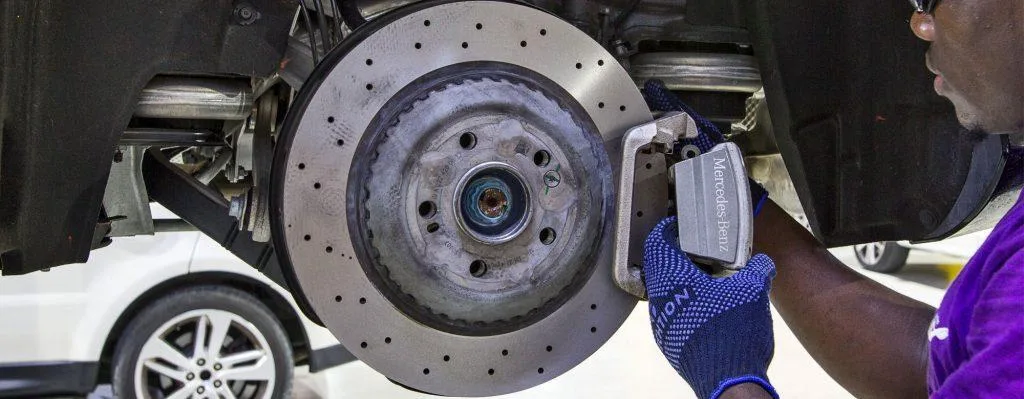Last updated on March 6th, 2024 at 04:55 pm
Understanding the ins and outs of your vehicle’s braking system is like unlocking a safety puzzle. When it comes to optimal brake performance, knowing “How Many Brake Pads per Wheel” holds the key.
Picture this: every time you hit the brakes, these crucial pads play a silent yet pivotal role in slowing down your ride. But how many are there, and why does it matter?
Imagine these pads as the unsung heroes tucked within your wheels, tasked with gripping onto the spinning disks to halt your car’s motion. Exploring this essential aspect demystifies the mechanics behind safe stops and ensures a smoother, safer journey on the road.
Let’s delve into this fundamental element, breaking down the role and significance of brake pads per wheel for a clearer ride ahead.
Brake Pads: Your Car’s Stopping Helpers
Imagine brake pads as silent heroes tucked within your wheels, pivotal in your car’s stopping power. When you press the brake pedal, these small yet essential parts leap into action. They’re a simple blend of a steel plate and friction material, crucial in halting your car’s motion.
How They Function
The brake pads operate when hydraulic fluid rushes to the wheels upon brake pedal pressure. Caliper pistons then push the pads against the rotors, creating friction that slows or stops the wheels.
Understanding Wear Factors
Think of your car’s wheels as tireless spinners on the road. Constantly using friction to halt them puts stress on these pads, causing gradual wear.
Driving style, frequency, and the pad type all impact their lifespan. Heavy traffic or frequent stop-and-go driving demands more from these pads, leading to more frequent replacements.
Understanding these nuances sheds light on when and why brake pads might need attention. It’s a crucial part of car maintenance, ensuring smooth and safe travels on the road.
Understanding Brake Components: How Many Brake Pads per Wheel?

Understanding your car’s braking system is like solving a puzzle. In disc brake setups, each wheel is equipped with a brake caliper, a disc rotor, and, crucially, two brake pads. The disc rotor, linked to the wheel hub, rotates at the wheel’s speed.
So, the question arises: “How many brake pads per wheel?” Well, it’s two—specifically, an inner and an outer brake pad per wheel. Many sports cars boast disc brakes on both front and rear axles. However, in numerous passenger cars, you’ll find disc brakes in the front and drum brakes in the rear.
In a car with brake pads on both front and rear axles, you’ll require two sets of brake pads—front and rear, each set comprising four pads, two for each wheel. But if your vehicle only uses pads on the front brakes, then one set of brake pads will suffice.
In cars with disc brakes on both front and rear wheels, the tally is eight brake pads—four on each end. However, if the rear axle sports drum brakes, the total reduces to four brake pads, focusing solely on the front wheels. Understanding this breakdown helps in ensuring the right brake maintenance for your car’s safety and performance.
RECOMMENDED POST Why My Oil Light Comes On When Braking – And What To Do
Worn Brake Pads: Signs You Need to Know
Here are the signs indicating bad or worn-out brake pads:
- Squealing or Squeaking Noises: High-pitched sounds when braking often indicate worn brake pads. They’re designed to produce this noise as a warning sign.
- Grinding or Metal-on-Metal Noise: If you hear grinding or harsh metallic sounds when applying brakes, it’s a severe warning. It suggests that the brake pads have worn down completely, and metal parts are rubbing against each other.
- Vibration in the Brake Pedal: Feeling unusual vibrations or pulsations through the brake pedal when stopping might signify worn-out brake pads.
- Reduced Brake Responsiveness: If your brakes feel less responsive or require more pressure to stop the vehicle, it could signal worn brake pads.
- Visible Thickness of Brake Pads: Inspecting the brake pads through the wheel spokes can sometimes reveal their thickness. If they appear excessively thin, it’s a clear indication of wear and potential need for replacement.
Being aware of these symptoms helps in timely maintenance and replacement of brake pads, ensuring safe and efficient braking performance.
Recommended Post Squeaking Noise While Driving But Not Brakes Applied
FAQs
Q: How many brake pads does a car have?
A: Cars equipped with disc brakes have two brake pads per wheel, totaling four or eight pads, depending on the vehicle.
Q: How often should brake pads be replaced?
A: Brake pad replacement depends on driving habits and mileage, usually between 10,000 to 40,000 miles.
Q: Do you need to change brake pads on both sides?
A: Yes, it’s recommended to replace brake pads on both sides of the same axle simultaneously for even wear.
Q: How frequent should I check my brake pads?
A: Regularly check for signs of wear or unusual noises, especially after driving regularly or in stop-and-go traffic.
Conclusion
Throughout this article, we’ve uncovered the mystery behind the number of brake pads per wheel in cars. Typically, every wheel houses two brake pads, adding up to four pads per axle.
However, the overall count of brake pads varies, totaling either four or eight, contingent on the vehicle’s braking setup.
Understanding this essential aspect, we’ve learned the fundamental role these brake pads play in ensuring safe stops and smooth rides.
So, the next time you wonder about “How Many Brake Pads per Wheel,” remember, it’s all about those crucial pairs of brake pads keeping your car’s stopping power in check.
Recommended Post Temporary Fix For Stuck Brake Caliper
Recommended Post Brake Fluid Leaking from Caliper Causes and Solutions
Recommended Post Noise When Braking at Low Speed (Causes & How To Fix)
Recommended Post The Signs and Causes of Low Brake Fluid
FOLLOW US
